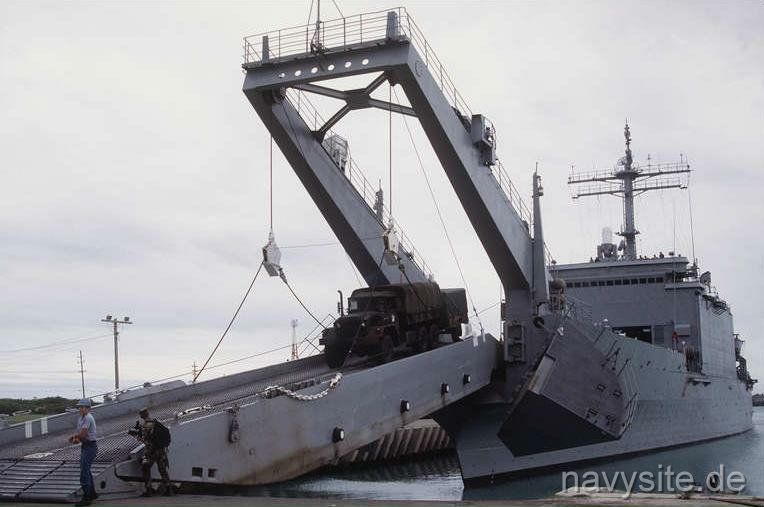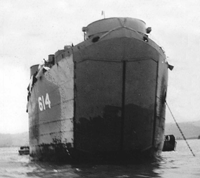Skip to comments.
The FReeper Foxhole Profiles the LST -- Landing Ships, Tank - April 9th, 2004
see educational sources
Posted on 04/09/2004 5:23:25 AM PDT by snippy_about_it
|

Lord,
Keep our Troops forever in Your care
Give them victory over the enemy...
Grant them a safe and swift return...
Bless those who mourn the lost.
.
FReepers from the Foxhole join in prayer
for all those serving their country at this time.

...................................................................................... ........................................... |
|
|
|
|
|
|
U.S. Military History, Current Events and Veterans Issues
 Where Duty, Honor and Country
Where Duty, Honor and Country
are acknowledged, affirmed and commemorated.
|

| Our Mission: The FReeper Foxhole is dedicated to Veterans of our Nation's military forces and to others who are affected in their relationships with Veterans. In the FReeper Foxhole, Veterans or their family members should feel free to address their specific circumstances or whatever issues concern them in an atmosphere of peace, understanding, brotherhood and support. The FReeper Foxhole hopes to share with it's readers an open forum where we can learn about and discuss military history, military news and other topics of concern or interest to our readers be they Veteran's, Current Duty or anyone interested in what we have to offer. If the Foxhole makes someone appreciate, even a little, what others have sacrificed for us, then it has accomplished one of it's missions. We hope the Foxhole in some small way helps us to remember and honor those who came before us.
To read previous Foxhole threads or
to add the Foxhole to your sidebar,
click on the books below.
|
|
|
|
|
|
TANK LANDING SHIPS (LST)

"Large Slow Target"
The British evacuation from Dunkirk in 1940 demonstrated to the Admiralty that the Allies needed relatively large, ocean-going ships capable of shore -to-shore delivery of tanks and other vehicles in amphibious assaults upon the continent of Europe. As an interim measure, three medium-sized tankers, built to pass over the restrictive bars of Lake Maracaibo, Venezuela, were selected for conversion becau se of their shallow draft. Bow doors and ramps were added to these ships which became the first tank landing ships (LST's). They later proved their worth during the invasion of Algeria in 1942, but their bluff bows made for inadequate speed and pointed up the need for an all-new design incorporating a sleeker hull.
At their first meeting at the Argentia Conference in August 1941, President Roosevelt and Prime Minister Churchill confirmed the Admiralty's views. In November 1941, a small delega tion from the Admiralty arrived in the United States to pool ideas with the Navy's Bureau of Ships with regard to development of the required ship. During this meeting, it was decided that the Bureau of Ships would design these vessels.

Within a few days, John Niedermair of the Bureau of Ships sketched out an awkward looking ship that proved to be the basic design for the more than 1,000 LST's which would be built during World War II. To meet the conflicting requirements of deep draft for ocean travel and shallow draft for beaching, the ship was designed with a large ballast system that could be filled for ocean passage and pumped out for beaching operations. The rough sketch was sent to Britain on 5 November 1941 and accepted immediately. The Admiralty then requested the United States to build 200 LST's for the Royal Navy under the terms of lend-lease.
The preliminary plans initially called for an LST 280 feet in length; but, in January 1942, the Bureau of Ships discarded these d rawings in favor of specifications for a ship 290 feet long. Within a month, final working plans were developed which further stretched the overall length to 328 feet and called for a 50-foot beam and minimum draft of three feet 9 1/2 inches. This scheme distributed the ship's weight over a greater area enabling her to ride higher in the water when in landing trim. The LST could carry a 2,100-ton load of tanks and vehicles. The larger dimensions also permitted the designers to increase the width of the bow door opening and ramp from 12 to 14 feet and thus accommodate most Allied vehicles. Provisions were made for the satisfactory ventilation of the tank space while the tank motors were running, and an elevator was provided to lower vehicles from the main deck to the tank deck for disembarking. By January 1942, the first scale model of the LST had been built and was undergoing tests at the David Taylor Model Basin in Washington, D.C.

In three separate acts dated 6 February 1942, 26 May 1943, an d 17 December 1943, Congress provided the authority for the construction of LST's along with a host of other auxiliaries, destroyer escorts, and assorted landing craft. The enormous building program quickly gathered momentum. Such a high priority was assigned to the construction of LST's that the keel of an aircraft carrier, previously laid in the dock, was hastily removed to make place for several LST's to be built in her stead. The keel of the first LST was laid down on 10 June 1942 at Newport News, Va. ; and the first standardized LST's were floated out of their building dock in October. Twenty-three were in commission by the end of 1942.

The LST building program was unique in several respects. As soon as the basic design had been developed , contracts were let and construction was commenced in quantity before the completion of a test vessel. Preliminary orders were rushed out verbally or by telegrams, telephone, and air mail letters. The ordering of certain materials actually preceded the completion of design work. While many heavy equipment items such as main propulsion machinery were furnished directly by the Navy, the balance of the procurement was handled centrally by the Material Coordinating Agency -- an adjunct of the Bureau of Ships -- so that the numerous builders in the program would not have to bid against one another. Through vigorous follow-up action on materials ordered, the agency made possible the completion of construction schedules in record time.
The need for LST's was urgent, and the program enjoyed a high priority throughout the war. Since most shipbuilding activities were located in coastal yards and were largely used for construction of large, deep-draft ships, new construction facilities were established along inland waterways. In some instances, heavy industry plants such as steel fabrication yards were converted for LST construction. This posed the problem of getting the completed ships from the inland building yards to deep water. The chief obstacles were bridges. The Navy successfully undertook the modification of bridges and, through a "Ferry Command" of Navy crews, transported the newly constructed ships to coastal ports for fitting out. The success of these "cornfield" shipyards of the Middle West was a revelation to the long-established shipbuilders on the coasts. Their contribution to the LST building program was enormous. Of the 1,051 LST's built during World War II, 670 were constructed by five major inland builders.

By 1943, the construction time for an LST had been reduced to four months; and, by the end of the war, it had been cut to two months. Considerable effort was expended to hold the ship's design constant; but, by mid-1943, operating experience led to the incorporation of certain changes in the new ships. These modifications included: the replacing of the elevator by a ramp from the main deck to the tank deck, an increase in armament, and the addition of a distilling plant to make potable water. The main deck was strengthened to accommodate a fully-equipped landing craft, tank (LCT).

LST launching LCT
From their combat debut in the Solomons in June 1943 until the end of the hostilities in August 1945, the LST's performed a vital service in World War II. They participated in the invasions of Sicily, Italy, Normandy, and southern france in the European Theater and were an essential element in the island-hopping campaigns in the Pacific which culminated in the liberation of the Philippines and the capture of Iwo Jima and Okinawa.
The LST proved to be a remarkably versatile ship. A number of them were converted to become landing craft repair ships (ARL). In this design, the bow ramp and doors were removed, and the bow was sealed. Derricks, booms, and winches were added to haul damaged landing craft on board for repairs, and blacksmith, machine, and electrical workshops were provided on the main deck and tank deck.

Another successful conversion was the LST "Mother Ship." This version of the standard LST hull had two Quonset huts erected on the main deck to accommodate 40 officers. Bunks on the tank deck berthed an additional 196 men. A bake shop and 16 refrigeration boxes for fresh provisions augmented the facilities normally provided the crew. Four extra distilling units were added, and the ballast tanks were converted for storage of fresh water.
Thirty-eight LST's were converted to serve as small hospital ships. They supplemented the many standard LST's which removed casualties from the beach following the landing of their cargo of tanks and vehicles. For example, on D-day, LST's brought 41,035 wounded men back across the English Channel from the Normandy beaches. Other LST's, provided with extra cranes and handling gear, were used exclusively for replenishing ammunition. They possessed a special advantage in this role, as their size permitted two or three LST's to go simultaneously alongside an anchored battleship or cruiser to accomplish replenishment more rapidly than standard ammunition ships. In the latter stages of World War II, some LST's were even fitted with flight decks from which small observation planes were sent up during amphibious operations.

Low tide at Normandy
Throughout the war, LST's demonstrated a remarkable capacity to absorb punishment and survive. Despite the sobriquet, "Large Slow Target," which was applied to them by irreverent crew members, the LST's suffered few losses in proportion to their number and the scope of their operations.Their brilliantly conceived structural arrangement provided unusual strength and buoyancy. Although the LST was considered a valuable target by the enemy, only 26 were lost due to enemy action, and a mere 13 were the victims of weather, reef, or accident.
A total of 1,152 LST's were contracted for in the great naval building program of World War II, but 101 were cancelled in the fall of 1942 because of shifting construction priorities. 0f 1,051 actually constructed, 113 LST's were transferred to Great Britain under the terms of lend-lease, and four more were turned over to the Greek Navy. Conversions to other ship types with different hull designations accounted for 116.
FReeper Foxhole Armed Services Links
 
   |
TOPICS: VetsCoR
KEYWORDS: freeperfoxhole; marines; navy; samsdayoff; tanklandingships; veterans; wwii
Navigation: use the links below to view more comments.
first previous 1-20 ... 41-60, 61-80, 81-100, 101-115 next last
To: SAMWolf
That is not fair :}}}}}}}}}
Stay safe Sam, God bless America and families whose love ones are in battle right now.
Bogdan
To: snippy_about_it
Sorta. Supposed to snow again this evening. This is depressing to me.
62
posted on
04/09/2004 11:03:03 AM PDT
by
Colonel_Flagg
("We will either find a way or make one." - Hannibal)
To: Professional Engineer
LOL! You're a great resource for the Foxhole. :-)
63
posted on
04/09/2004 11:07:13 AM PDT
by
SAMWolf
(Proofread carefully to see if you any words out.)
To: bogdanPolska12
That is not fair I know but I'm gonna enjoy it anyway. :-)
64
posted on
04/09/2004 11:08:23 AM PDT
by
SAMWolf
(Proofread carefully to see if you any words out.)
To: SAMWolf
wise ass :}}}}}}}}}}}}
lol, thanks Sam
God Bless
Bogdan
To: bogdanPolska12
wise ass LOL. I see you know our Sam well. ;-)
66
posted on
04/09/2004 11:22:07 AM PDT
by
snippy_about_it
(Fall in --> The FReeper Foxhole. America's History. America's Soul.)
To: Colonel_Flagg
Snow would depress me too, it always did.
67
posted on
04/09/2004 11:22:29 AM PDT
by
snippy_about_it
(Fall in --> The FReeper Foxhole. America's History. America's Soul.)
To: bogdanPolska12
Everyone likes a little ass but no one likes a wiseass. :-)
68
posted on
04/09/2004 11:50:31 AM PDT
by
SAMWolf
(Proofread carefully to see if you any words out.)
To: SAMWolf
O lord, sam, lol, bwhehehehe.
Happy Easter buddy
Bogdan, you are cracking me up here. Oh man
To: snippy_about_it
"Battling Bastards of Bataan" Camp O'Donnell Memorial Monument

"The Battling Bastards of Bataan, No Mama, No Papa, No Uncle Sam, No aunts, no uncles, no cousins, no nieces, No pills, no planes, no artillery pieces, And nobody gives a damn!" by Frank Hewlett, 1942.
To: snippy_about_it
A SpankenTruppen for Snippy.

To: SAMWolf
And the lesson we learned from this is, don't take a large warship into a narrow fjord.
72
posted on
04/09/2004 4:09:17 PM PDT
by
Valin
(Hating people is like burning down your house to kill a rat)
To: snippy_about_it
Let's just say I have my sources, and leave it at that. :-)
73
posted on
04/09/2004 4:12:28 PM PDT
by
Valin
(Hating people is like burning down your house to kill a rat)
To: Professional Engineer
I like my men a tad more manly than that! LOL. I'll get you for this.
74
posted on
04/09/2004 4:33:40 PM PDT
by
snippy_about_it
(Fall in --> The FReeper Foxhole. America's History. America's Soul.)
To: snippy_about_it
Coolbeans!
75
posted on
04/09/2004 5:18:52 PM PDT
by
Darksheare
(Fortune for the day: I may or may not actually be scarier in real life, but I play it on TV!)
To: snippy_about_it; SAMWolf
we are warmung a little, today was really nice, sunny and in the 40's.
nice taste of spring....
76
posted on
04/09/2004 5:42:06 PM PDT
by
The Mayor
(Death separates us for a time; Christ will reunite us forever.)
To: snippy_about_it; SAMWolf
And here I thought they just drove 'em up on the beach and opened the doorsI kind of thought that when I got on my first LST. I had no idea what a complicated evolution beaching was.
For our part in navigation, the most critical part was determining when the stern anchor would be dropped. An LST retracts from the beach using the stern anchor. Engines alone will not do it. Drop too early and you run out of cable before you ground out (very embarassing and good for an ass chewing from the captain). Drop too late and the stern anchor won't have enough cable out to pull you off.
Beaching speed was slow-about 2 or 3 knots. I only remember one time really feeling a jolt when we stopped. And we never did the high and dry thing like the WWII pics.
Once beached we constantly took bearings to watch our movement. Too much movement while beached was not good, but on the other hand, if there was no movement at all the ship might be digging itself a big hole which would be hard to get of.
LSTs were interesting ships for navigation. I can say with pride I've run agound tens of times in my 7 1/2 years spent on LSTs and never got in trouble for it.

NEWPORT class bow ramp. Designed for the LST to have a normal hull configuration at the bow to enable 20 knot speed.
To: snippy_about_it; SAMWolf

One thing the article neglected-no ship rode as badly as an LST. Old style or new they were terrible rollers, and it was quick snapping roll that you never got used to. We had a bell on the bridge. It would ring by itself if the ship rolled 53 degrees. It rang quite a few times.
To: snippy_about_it; SAMWolf
The first pic gives you a good idea of the hieght of the wave in the second pic.
To: snippy_about_it; SAMWolf; E.G.C.; bentfeather; Valin; Professional Engineer; GATOR NAVY; ...
80
posted on
04/09/2004 7:20:56 PM PDT
by
PhilDragoo
(Hitlery: das Butch von Buchenvald)
Navigation: use the links below to view more comments.
first previous 1-20 ... 41-60, 61-80, 81-100, 101-115 next last
Disclaimer:
Opinions posted on Free Republic are those of the individual
posters and do not necessarily represent the opinion of Free Republic or its
management. All materials posted herein are protected by copyright law and the
exemption for fair use of copyrighted works.
FreeRepublic.com is powered by software copyright 2000-2008 John Robinson












